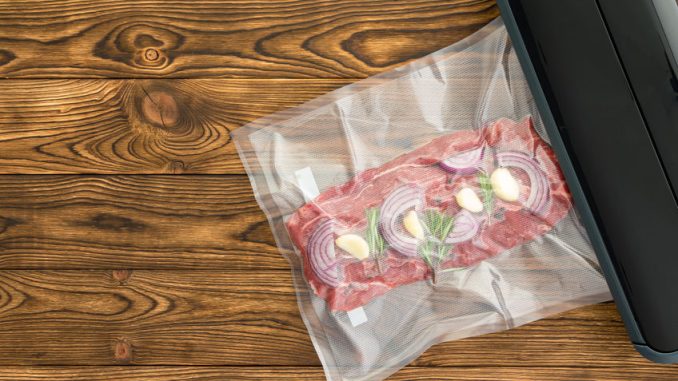
Vacuum packaging of food products provides a new dimension of the both the home producer and the commercial manufacturer. Why? It’s all about extending the shelf-life of what would be highly perishable foodstuffs. The types of food we are talking about is generally fresh produce and some of the most perishable are amenable to this technique. One of the most susceptible to rapid deterioration is fish and other types of meat simply because the proteins are susceptible to bacterial attack and the flesh itself soon rots on exposure to air. using a vacuum to pack food by removing air simply means there is no reactive gaseous material available to continue to the process of deterioration or indeed support may form of microbial life. Even an anaerobic microorganism would find it difficult to continue metabolising in a vacuum!
Vacuum packaging is a type of modified atmospheric packaging in which air is removed from the pack completely and sealed. The packaging must be impermeable to oxygen so that no air can pass through and spoil the vacuum and then contribute to food spoilage. Vacuum sealing requires a heat source to seal the packaging following removal of air. Vacuum packaging can probably extend the life a food stuff by 5 times compared to other conventional food storage methods.
One of the reasons why vacuum packaging has become so popular is it lends itself to ‘sous vide’ cooking. This is the process whereby a food is cooked under vacuum so that whilst there is a heat-based process it is gentle enough not to ruin the flavour of the fish and can generate a quality of product not found elsewhere. It also means the nutrients, taste and texture are preserved to a large extent and with it the quality of a fresh food is conveniently preserved albeit for a limited period but longer than having to consume it straight after the harvest. It also means that home cooking can produce restaurant quality food by bringing a sophisticated process into the home.
What Is Sous-Vide Cooking By The Way?
It’s worth reminding ourselves what ‘sous-vide’ means:-
“raw materials or raw materials with intermediate foods, that are cooked under controlled conditions of temperature and time inside heat-stable vacuum pouches.” (Schellekens and Martens, 1992). What this means in effect is that ‘sous vide’ cooking is conducted at relatively mild temperatures for a long period of time. Following heating, the food in a pouch say can be cooled extremely quickly and then kept at chilled storage temperature without freezing. A temperature of between 1 and 4ºC is optimum. On that basis the shelf-life then ranges from 6 to 42 days.
What Else Can be Done With Vacuum Packaging?
Vacuum packaging and sealing can also be combined with other agents to add to the preservation power of the technology. Quite a few producers of fish for example will add preservatives like potassium sorbate or sodium benzoate to the materials in a fish product to maintain integrity. However preservation is not the only reason for adding other ingredients – marinades and gravies which season or flavour a food such as meat are very much in vogue. Indeed, it is one of the ways to keep a food sealed with its marinade for longer and more conveniently than just placing in a tough, unflexible container.
For the home producer looking to vacuum package foods, most foodstuffs are conveniently stored in pouches made of polyester. A 12 micron width polyester laminated with say 75 micron low-density polyethylene is ideal.
The pouch is tested according to various techniques. It will be defined by its physical properties such as heat-seal strength, the tensile strength and elongation at break of a pouch are common measurement parameters. The following methods are available:
- ASTM. 1973. Standard Methods of Test for Seal Strength of Flexible Barrier Materials. D 6012, American Society for Testing and Materials,
McGraw-Hill Book Co. Inc., New York, NY. - ASTM. 1987. Standard Method for Determining Gas Permeability Characteristics of Plastic Film And Sheeting. D 1434, American Society for
Testing and Materials, McGraw-Hill Book Co. Inc., New York, NY
Products
A number of producers now offer cut vegetables which are packaged under vacuum to preserve their freshness without resorting to freezing. These are of course read-to-eat veggies that have been produced by the sous vide method. Straight From The Root is a firm distributing ready-to-eat vegetables that are produced by the sous-vide method. These are eaten straight from the package and can then be rewarmed or heated in a microwave in under a minute. In this case the vegetables are cut and then immediately placed in vacuum-sealed bags for cooking in a controlled temperature water bath. The bags must then be blanched rapidly in an ice bath to stop the cooking process dead. It does result in tender, fresh flavoured vegetables which are evenly cooked and have not turned to mush. Along with this benefit in flavour and texture comes a product retaining as much nutrients – vitamins and minerals as possible. Perhaps most significantly is the retention of shelf-life from a a week at best to 45 days at a chill storage temperature. Straight From The Root offer all sorts of veggies including honey gold potatoes, butternut squash, sweet potatoes , red beets and baby carrots.
Home vacuum sealers
Nowadays there is a wide range of vacuum sealer available for home use. They are not as expensive as they use to be and they are ideal for dealing with small batches off foodstuffs. Some of the top electrical white goods suppliers have excellent machines available for home use. Some of the claims made on various machines are quite staggering. The Food Saver V2244 vacuum sealer machine is a compact device that can be used to produce vacuum packed meat and fish that can be stored in the freezer for up to 3 years without losing its taste or developing the infamous freezer burn.
Many vacuum packaging machines are designed for the home. Most are designed by cutting the vacuum bag to a desired size and then sealing one end, filling and then filling the bag to point where it is not overfilled. The open end of the bag is placed within the main body of the vacuum sealer. All air is sucked out and the pouch sealed.
Good brands include Litimall, Bonsenkitchen, KitchenBoss, DiiDa, Freshlocker, Godmorn, iLymh and Uten. Most of these machines also have their own supplies of vacuum seal roll.
What Else Can We Do With Vacuum Packaging?
As well as sous vide cooking, we can use vacuum packaging with vacuum blenders, for marinating foods, for fermentation, for coffee and with cannabis.
Coffee beans are ideal for vacuum sealing because they keep their quality. The shelf-life of coffee readily deteriorates in the presence of oxygen in the atmosphere and so creating a vacuum chamber to remove the air means that coffee beans and indeed ground coffee can be stored relatively well. It is known though that any flexible packaging expands as carbon dioxide which remains inside a bean leaches out and fills the package.
Using a carbon dioxide scavenger sachet helps with removing the carbon dioxide produced. These have been incorporated into the vacuum bags and cans. They are composed of calcium hydroxide but also use potassium hydroxide.
References
Schellekens, M. and Martens, T. (1992). Sous Vide State of the Art (Publication EUR 15018 EN), p. 185, ALMA, Leuven, Belgium


We are coffee suppliers and I know that there is a problem with bags blowing if we get the vacuum packing wrong. I would like to contact you further for details because this is such useful information. Would you send us an email so we can discuss further. I do not think vacuum packing is the real issue on this but you never know. Something in the beans is still reacting so could it be a bad roasting process.